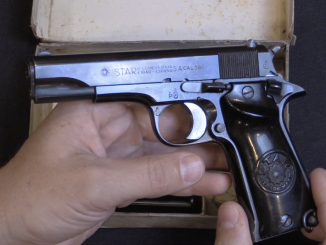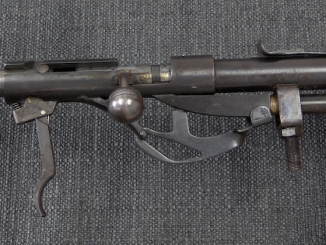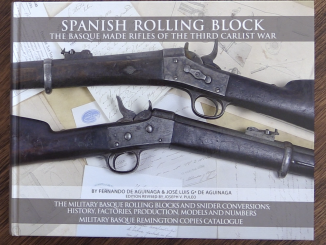From Vesamatti, a Finnish gunsmith student who reads the site, we have this neat video of a few older Finnish Army machine guns. The KP-31, KP-44, Sten, KVKK, and DP-27. Not guns we get all that much exposure to here in the US (except for the Sten…) – thanks Vesamatti!
https://www.youtube.com/watch?v=JmEi2wVsSXA
Another video pointed out to me (I lost track of who sent it; sorry!) is a part of a documentary on Canadian volunteers in the Spanish Civil War. Very interesting material, both form a historical perspective and a gun perspective. In this particular section (it’s part 5 of 6), we get glimpses of a bunch of different machine guns in use – two Maxim-Tokarevs, a Hotchkiss 1924, a Hotchkiss 1914, and a Chauchat.
Lastly, I have a new video of my own to publish today, on bolt disassembly of the Hungarian 35M, 43M, and G98/40 rifles. A new set of Rock Island Auction videos will be starting next week, and one of them covers this family of three related rifles. I figured that some folks would be interested in just a tutorial on their bolt disassembly without sitting through all the other material, so I decided to make the bolt section a standalone video for easy reference:




Loved the Finnish guns! The KVKK is a favourite of mine.
“The KP-31, KP-44, Sten, KVKK, and DP-27”
I don’t want to be malicious, but correct designation is DP not DP-27.
Наставление по стрелковому делу. Ручной пулемет ДП (Field Manual for DP machine gun) always refers to this weapon as ДП (DP). Similarly there is no AK-47 but AK.
“Spanish Civil War. Very interesting material”
This war was good opportunity for many countries to sell surplus weapons and equipment, mainly from WW1.
“Hungarian 35M, 43M, and G98/40 rifles”
For information concerning this rifles as well other Hungarian fire-arms see:
http://hungariae.com/
Did you noticed Emma (DP) shooting long after trigger was released? Big Brother knows better how long a burst you want to shoot… Also, take a note of constant wiggling on the grip safety – anyone who fired that beast recognizes it immediately. Vassily Alexeevich took some perverted pride in this gem of anti-ergonomics, and it took until DPM in 1944 to finally rectify it by simply replacing the DP lower with a DT one, complete with pistol grip. At the same time the return spring was replaced form the gas piston, when it heat-deteriorated rather quickly to the tube behind the bolt carrier, in both DT (now DTM) and DP (now DPM).
Дегтярев in his memoirs (Моя жизнь, 1950) states that:
-ball mount for DT was designed by Шпагин [SPSh Flare pistol and PPSh sub-machine gun designer] (page 126)
-telescoping stock of DT machine gun was also designed by Shpagin (page 128)
-in 1929 observed Red Army exercises, where he collected opinions and suggestions from users of his machine gun. After this exercises Ворошилов [then People’s Commissar for Defense of the Soviet Union] ordered big-bore machine gun (page 128)
-this big-bore machine was developed by all designers, not only by Дегтярев, during trials of this design Ворошилов personally fired few shots (page 129)
-during WW2 some new patterns of weapons were designed, during this time Shpagin stood out from others. Shpagin helped improved big-bore machine gun [DSh in DShK stands for Дегтярев-Шпагин](page 130)
Spanish clip – anyone recognized Lepage semi-auto just after Internationale? Maxim-Tokarev LMG! Wow, that’s the first time I see that gun in action. Nice footage, although sometimes misused. Italian Carro Veloce footage illustrating the words about Republican advance with tanks, and the Eytie Savoia-Marchetti SM79 bomber to illustrate German aid…
Just to add a bit of historical background to the Spanish Civil War clip, you will notice a reference to the “Mackenzie-Papineau Brigade” and to the dates “1837 – 1937”. The year 1937 of course was referring to the Spanish Civil War. The year 1837 however refers to a “rebellion” (failed revolt) in Canada, whose leaders were Mackenzie and Papineau. That revolt was quite comprehensively crushed by the Canadian militia (army reserve).
This isn’t the place to discuss those events in depth, but I thought the above might save a bit of time for anyone wondering what those banners were referring to.
One thing that really struck me in that clip was where one guy said that going into one major battle his platoon had a total of 15 rounds of ammunition and 2 hand grenades between them. That really brings home how it’s not just having a *rifle* that matters, it’s having a rifle *and* ammunition for it. Without ammunition, a rifle is just a heavy and somewhat clumsy spear or club.
Perhaps Ian would like to do a few posts on ammunition some time. There was a much greater variety of it in the early part of the 20th century than there is today, and tracing the development and derivation of it could be quite interesting.
This is an excellent remark MG!
I recall reading or hearing about mentioned revolt; I believe it initiated in Prairies in following of Depression. It is apparently not talked about much in popular version of history. Those chaps who participated in it naturally gravitated to continue same struggle (as they thought) somewhere else. Of course, the Quebecois opposition element was pretty well ongoing and it found its suitable outlet.
@Denny – I think you’re mixing up several widely separated events. I was referring to the 1837 rebellion in Upper and Lower Canada (Ontario and Quebec). It was a rebellion by certain populist elements against the small groups of wealthy families who ran things to their own benefit. This no doubt was the reason for the Spanish Civil War fighters borrowing their names, although there was in fact no political continuity in organization or in ideology. However, in 1837 the establishment in Canada successfully painted the rebels as puppets of the Americans (rather like Russia in Ukraine today), and public opinion turned strongly against the rebels and the rebellion was totally crushed by the militia.
I think the incident you are referring to was the Winnipeg General Strike of 1919. This was a series of strikes and protests after WWI for which the root cause was economic distress in the aftermath of the war, including inflation and unemployment. It found it’s peak in Winnipeg (which was the largest city on the prairies at the time). There was also some degree of Communist agitation, as was the case in many places in that era, but it would not be correct to simply brand them all as “communists”. The strike was put down with some violence, but there were no actual armed battles fought, so it doesn’t deserve to be considered a “rebellion”. It was instead a series of strikes and public protests. The biggest incident was “Bloody Sunday” when the RCMP charged in on horseback to disperse a large crowd of protesters after the Riot Act had been read. In the aftermath of this, a Royal Commission was struck to investigate the causes, and various political and labour reforms were implemented to address the worst grievances.
The participation of people in the International Brigades in the Spanish Civil War has to be viewed in the context of the times. To many of the participants, it was all part of a world wide struggle of Socialism or Populism (depending on local conditions) versus Fascism. By fighting in Spain, they believed they were helping their own cause back home.
And before was dismiss these people as “communists”, for most of the rank and file they would have been very happy to have what we now take for granted today.
I have met two U.S. veterans of the Spanish Civil War. One was an Abe Lincoln vet. The other was destined for the “George Washington’ outfit, but there were not enough of them left alive after Jarama. He was sent to the MacPaps or Mackenzie-Papineau Bn.
Most of the Canadian volunteers in the Ejército Popular de la RE were actually Finns! Red Finns formed a majority of the combatants who journeyed from Canada to the Spanish Republic.
unrelated but is there good info on the Gast gun somewhere?
Try starting with Ian Hogg’s “Machine Guns : 14th Century To Present” ( Krause Publications, 2002 / Library Of Congress Catalog Number 2001091076 ). Although necessarily condensed due to the encyclopaedic format of the book, it will give you a good starting point if you already haven’t read it. The description of the Gast MG17 ( not to be confused with the later MG17 7.92mm aircraft MG, itself a development of the MG15, which originated as the Solothurn T6-220, and which incorporated elements of Louis Stange’s Rh29 MG )can be found on Page 84.
thank you!
Watching that part on Canadian participation I realized I did not see this before. It is very telling about destinies od Canadian volunteers. It makes me to come back and see more of it.
On technical side, at beginning the officer shooting Astra pistol had a stoppage and was left in lurch for couple of seconds; quite funny, if it was not a war.
I’m pretty sure that that was none other than Enrique Líster. A Gallego, like Franco. Pro-Soviet PCE member. He went to the USSR after the Republic lost. He was among the “Hispano-Soviets” that went to Cuba just after the 1959 revolution to assist the Castro regime with organizing the FAR.
Is there any manuals on Valmet KV62 machine gun available??
All I see is general information in Wiki
http://en.wikipedia.org/wiki/Kk_62
It makes mighty impression; I first thought it was in 7.62x54R.
Speaking of the Suomi KP-31, it is painful to see how imported KP-31 kits in the U.S. have to have their receivers torch-cut by law — an awful waste not only of an outstanding original gun with so much going for it, but also a marring of it’s historical value.
Kiitos Vesamatti!
Moar KP/44!!
One of those with some 50-rd. KP/31 Suomi “coffin magazines”… Oh yeah!
How did a Sten end up in Finland? It must have had an interesting journey.
The UK sold surplus STENs to Finland after WWII.
However the Sten ended up there, it should be pointed out that holding it by the magazine is a good way to get a stoppage. Nonetheless, it is good to see that in Finland students of firearms are still able to own full auto guns and use them at the firing range. I hope that they can ensure that this freedom continues; in the UK it was extinguished as far back as 1937.
When I fired a 9mm Sten Mk.II, I ended up holding underneath the trigger mechanism cover, with my fingers curled as if I was using a very sharp kitchen knife…
Holding the short barrel jacket made me nervous: too close to the muzzle for my taste, and my fingers near the ejection port and reciprocating bolt…
Holding the magazine housing seemed quite awkward to me, and I didn’t want to “learn” the hold while running the gun.
I’d greatly prefer the Sten Mk.III or even the Mk.I over the Mk.II, personally.
Dave:
I have only ever used a Sten MkII converted to semi-auto, but personally I had no problem holding it by the barrel jacket. However I tend to agree that the MkIII is probably easier to grasp, though it cannot be taken down in the same way the MkII can.
Thank you for the comments on my video. The Sten is indeed one of the guns bought from the UK to compensate the lack of automatic weapons after WWII. I don’t know how much the Sten was used in training, or were they mostly stored in case of war. I like the Sten. Simple, rugged and does what it was made for. We had no problems with it.
The DP’s gas port probably needs a little adjustment, and should work fine after that. 🙂
The “coffin” magazine was notoriously unreliable, and they have become a bit of a collectors item. It would be nice to try one in the KP44 one day. The “peltikonepistooli” (literally tin plate submachine gun) is my favorite of the bunch. It handles nicely, it’s fairly accurate, idiot proof and I would still consider carrying one into battle, should the need arise. 😉
I got training with the KvKK during my time in the army. It wasn’t my favorite back then, and still isn’t. It’s not very comfortable too shoot, it’s bulky and heavy and requires a lot of maintenance. The gases are directed straight into the receiver, and the weapon becomes prone to jamming with sustained fire. I prefer the RPD over the KvKK. There was talk about making a more detailed video of the KvKK later this year.
Vesamatti:
First, may I commend you on your command of English, which is far better than my non-existent Finnish!
Secondly, can you give me an idea of the legal requirements for owning full auto guns in Finland? In Britain this has been practically impossible since 1937, so the idea seems very foreign to us, sadly.
Thank you for the compliment.
Owning a full auto weapon is possible, if you are a licensed gun collector. However getting a collectors license isn’t easy, and even more difficult if you wish to own full auto guns. There are a few private collectors though who have the proper license. Also those who have the license to own for example a submachine gun may not be allowed to shoot it. However, I don’t think many (if any) such licenses have been granted since the 2007 school massacre, which created a hoplophobic hysteria which hasn’t died down to this day (I could go on about this subject for a while 😀 ) . The guns in my video aren’t privately owned.
Well I am glad that you can at least still experience shooting these guns, in Britain that has long been an impossibility.
One of my favorites, albeit I’ve only seen the peltikonepistooli or peltiheikki in pictures. That and the Spanish-produced ex-Tikka German engineer “DUX” version apparently sold to the West German/BRD Bundesgrenzschütz…
In the 1950s, these pelti-kp/44s were modified to accept the Swedish M45 C-Gustaf magazine too, yes? Those are usually cited as particularly reliable magazines. Again, I’ve not got any first-hand experience.
I didn’t have any problems with the Sten Mk.II, but I didn’t have to use it for an extended period.
Again, kiitos!
I have gotten the impression that Sten smgs were mainly given to artillery and mortar crews (I have seen photos of mortar crew members with Sten on their back) as well as the conscripts who were “manning the desk” / watch duty at the barracks. Back when my father was in the army whoever was in desk duty (and standing guard in the barrack during the night) had the Sten at the desk. The magazine had been welded onto the gun and the bolt was sealed in such a way that arming the gun would be seen afterwards. The point was that in case of disturbance the soldier in watch duty would have a loaded gun with some ammo. (During my time we just got a club…)
Stens really weren’t that highly respected, they were seen as cheap guns that were used when there was nothing better available (which is the job they were designed for in fact.)
Meanwhile the KVKK62 is almost universally hated by the conscripts and career soldiers. I have met exactly one person who liked it. The PKM was much more reliable and KVKK has a long list of annoying features. The only real advantages are the bipod which is apparently better than the one on PKM (not sure how it measures with MG3 the other, other light machinegun that Finnish military uses. …They came with the Leopard 2s and the units that have tanks gave them to the Jaegers as well since they liked them.) and the fact that KVKK uses the same ammo as the assault rifles so logistics are a bit easier.
KvKK is a damn nightmare. Accuracy’s so-so, it’s heavy and a bitch to maintain, not to mention the trigger bites you occasionally. Had a training session where my hand was numb from the trigger biting my finger.
PKM is better. Not much better in the weight department, but that thing’s solid iron by performance.